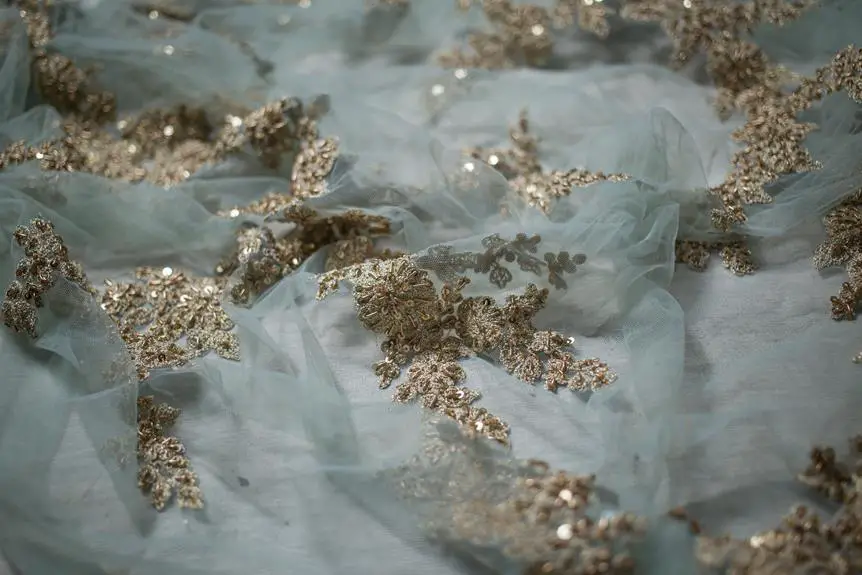Curiosity killed the cat, but satisfaction brought it back! You're about to unravel the mystery of lace fabric—natural or synthetic?
Lace has a rich history and intricate beauty, but what exactly is it made of? The answer lies in the fibers.
Natural lace is crafted from materials like cotton, silk, or wool, while synthetic lace is created from man-made fibers such as polyester or nylon.
Understanding the production process and properties of each type will empower you to make informed choices when selecting lace fabric for your projects.
Let's delve into the world of lace and discover the differences between natural and synthetic varieties.
Key Takeaways
- Lace fabric originated in Europe in the 15th century and was initially made by hand.
- Natural materials such as cotton, silk, linen, and wool are commonly used in lace fabric.
- The sustainability of lace depends on the sourcing of natural materials and the use of eco-friendly practices.
- Synthetic lace is made from materials like polyester and nylon, mimicking the delicate patterns of traditional lace.
History of Lace Fabric
The history of lace fabric dates back to the 15th century when it first gained popularity in Europe. The evolution of lace making is a fascinating journey that reflects the cultural significance of this delicate material.
Lace making began as a laborious process, crafted by hand using bobbins and pins. Over time, technological advancements revolutionized the production of lace, making it more accessible to a wider audience.
The intricate art of lace making was initially exclusive to the noble and wealthy classes, symbolizing prestige and luxury. However, as techniques evolved, lace became more attainable, leading to its integration into various aspects of daily life. Its cultural significance expanded as it became a symbol of femininity, appearing in fashion, home décor, and even religious ceremonies.
The evolution of lace making not only transformed the fabric itself but also influenced societal norms and traditions. Today, lace continues to be cherished for its timeless elegance and remains a vital part of many cultural celebrations and attire.
Understanding the history and cultural significance of lace fabric provides insight into its enduring allure and timeless appeal.
Natural Materials Used in Lace
When it comes to the natural materials used in creating lace fabric, you'll find a rich history and tradition that dates back centuries.
The origins of lace fabrication, the sustainability of using natural materials, and the various types of natural lace available are all important points to consider.
Understanding these aspects will give you a deeper appreciation for the artistry and craftsmanship that goes into creating this delicate and intricate fabric.
Lace Fabric Origins
One common natural material used in lace is cotton, which gives lace fabric its soft and breathable qualities. Cotton is a staple fiber in lace fabric production due to its versatility and comfort.
Another natural material often used in lace is silk, known for its luxurious feel and lustrous appearance. Silk is intricately woven into lace using traditional craftsmanship, adding elegance to the fabric.
Linen is also used in lace production, offering a crisp and textured look to the fabric. This natural material is favored for its durability and ability to hold intricate lace patterns.
Lastly, wool is occasionally used in lace, providing warmth and structure to the fabric.
These natural materials, combined with traditional craftsmanship, contribute to the unique origins of lace fabric.
Sustainability of Lace
Considering the natural materials used in lace fabric, you can assess its sustainability based on their environmental impact and renewability.
The sustainability of lace largely depends on the sourcing of its natural materials such as cotton, silk, and linen. Cotton, while a common lace material, has high water and pesticide usage in its cultivation, impacting the environment. However, organic cotton and linen offer more sustainable alternatives due to their lower environmental impact and renewability.
Silk, although natural, has complex production processes that can affect its sustainability. Sustainable lace production involves using eco-friendly dyes, reducing water and energy consumption, and ensuring fair labor practices.
Types of Natural Lace
How can you identify natural lace and its key materials? Natural lace is often identified by the use of traditional techniques and unique patterns. The key materials used in natural lace include cotton, silk, and linen. These materials are known for their breathability, softness, and luxurious feel, making them ideal for creating delicate and intricate lace fabrics.
| Types of Natural Lace Materials | Characteristics |
|---|---|
| Cotton | Soft, breathable, and versatile. |
| Silk | Luxurious, smooth, and lustrous. |
| Linen | Strong, durable, and crisp. |
Understanding the characteristics of these natural materials can help you differentiate between natural and synthetic lace, allowing you to make informed choices when selecting lace fabrics for your projects.
Synthetic Materials Used in Lace
Now let's talk about the synthetic materials used in lace.
You'll be surprised to learn about the diverse origins of synthetic lace, from nylon to polyester.
Understanding the composition and benefits of synthetic lace will give you a whole new perspective on this versatile fabric.
Synthetic Lace Origins
When creating synthetic lace, manufacturers utilize various synthetic materials to mimic the delicate and intricate patterns of traditional lace fabric. These materials include:
- Polyester: This widely used synthetic material is known for its durability, making it a popular choice for synthetic lace development. It is, however, important to consider its environmental impact, as polyester production involves high energy consumption and the release of greenhouse gases.
- Recycling Initiatives: Some manufacturers are implementing recycling initiatives to minimize the environmental impact of polyester lace production.
- Nylon: Another common material used in synthetic lace, nylon is prized for its strength and elasticity. However, the production of nylon raises environmental concerns due to its reliance on petroleum-based resources.
- Sustainable Alternatives: Innovations in eco-friendly nylon production aim to reduce its environmental impact, promoting sustainability in synthetic lace manufacturing.
Lace Fabric Composition
When creating synthetic lace, manufacturers utilize various synthetic materials to mimic the delicate and intricate patterns of traditional lace fabric. Nylon, polyester, and rayon are commonly used in the composition of synthetic lace.
Nylon provides strength and durability, making the lace fabric more resilient, while polyester adds wrinkle resistance and color retention, enhancing the fabric's longevity. Rayon, a semi-synthetic material, contributes to a soft and luxurious feel. These synthetic materials enable lace fabric to withstand regular wear and tear, enhancing its durability.
To care for synthetic lace, gentle hand washing or the use of a delicate cycle on your washing machine is recommended to maintain its delicate nature. Additionally, air-drying and storing lace fabric properly can help preserve its quality over time.
Synthetic Lace Benefits
Synthetic lace benefits from the use of durable and resilient materials such as nylon, polyester, and rayon, contributing to its longevity and wearability. This results in several advantages for the wearer:
- Durability: Synthetic lace is highly durable, making it resistant to tears and fraying, ensuring that it can withstand regular use without losing its shape or integrity.
- Versatility: The use of synthetic materials allows for a wide range of colors and designs, making it versatile for various fashion applications, from elegant evening gowns to casual tops.
Additionally, the affordability of synthetic lace makes it an accessible option for individuals looking to incorporate lace into their wardrobe without breaking the bank.
These benefits make synthetic lace a practical and attractive choice for a variety of fashion and textile needs.
Production Process of Natural Lace
To create natural lace fabric, artisans use traditional weaving and knitting techniques with organic fibers such as cotton, silk, or linen. Handmade lace is meticulously crafted by skilled artisans who often use age-old methods, including bobbin lace making or needle lace. The environmental impact of producing natural lace is relatively low compared to synthetic alternatives. Organic fibers like cotton, silk, and linen are biodegradable, reducing the environmental footprint of lace production. Furthermore, the traditional techniques used in creating natural lace often require minimal energy consumption and don't involve the use of harsh chemicals, making it an eco-friendly choice.
The process of creating natural lace involves attention to detail and a deep understanding of the properties of the chosen organic fibers. Artisans carefully select the finest quality materials and employ intricate handiwork to craft delicate and intricate lace patterns. The result is a fabric that embodies both elegance and sustainability.
Production Process of Synthetic Lace
If you're curious about the production process of synthetic lace, it's typically created using chemical processes and synthetic fibers such as polyester or nylon. The manufacturing of synthetic lace involves intricate steps, and it's essential to understand the environmental impact and ethical considerations associated with its production.
- Synthetic Lace Production
- *Chemical Treatment*: Initially, the synthetic fibers undergo chemical treatment to enhance their strength and durability, making them suitable for lace production.
- *Loom Weaving*: Once treated, the fibers are woven together using specialized looms to create intricate lace patterns. This process requires precision and expertise to achieve the desired lace designs.
When considering the environmental impact, it's important to note that the chemical treatment of synthetic fibers can contribute to pollution and environmental degradation. Additionally, the disposal of waste materials from the manufacturing process can pose challenges for waste management and sustainability efforts.
Ethical considerations in synthetic lace manufacturing include ensuring fair labor practices, safe working conditions, and responsible waste disposal. These aspects are crucial for maintaining ethical standards and promoting sustainability in the production of synthetic lace.
Properties of Natural Lace Fabric
Natural lace fabric is known for its delicate and intricate patterns, which are created using traditional weaving techniques and high-quality natural fibers. When it comes to the properties of natural lace fabric, it offers a unique blend of durability and breathability that make it an ideal choice for various garments and decorative items. Here is a table summarizing the key properties of natural lace fabric:
| Property | Description |
|---|---|
| Durability | Natural lace fabric, typically made from materials such as cotton, linen, or silk, is known for its strength and resilience. It can withstand regular wear and tear, making it suitable for long-lasting use in clothing. |
| Breathability | One of the standout features of natural lace fabric is its breathability. The open weave structure allows for excellent air circulation, making it comfortable to wear in warm weather and reducing the risk of moisture build-up. |
Natural lace fabric's durability and breathability set it apart, making it a sought-after choice for those seeking both resilience and comfort in their garments and home decor.
Properties of Synthetic Lace Fabric
Synthetic lace fabric is made from man-made materials and often exhibits consistent texture and color. When it comes to the properties of synthetic lace fabric, there are a few key points to consider:
- Durability: Synthetic lace fabric is known for its durability, making it resistant to wear and tear. This durability makes it a practical choice for garments and home decor items that require frequent use and washing.
- Cost Effectiveness: Synthetic lace fabric is often more cost-effective than natural lace fabric. Its affordability makes it an attractive option for those seeking a budget-friendly yet stylish fabric for various projects.
Synthetic lace fabric's durability and cost-effectiveness make it a popular choice for a wide range of applications, from fashion to interior design. Its ability to maintain consistent texture and color over time, along with its affordability, makes it a practical and versatile option for anyone seeking a reliable and visually appealing fabric.
Comparing Natural and Synthetic Lace
When comparing natural and synthetic lace, you'll notice differences in their texture, durability, and cost.
Natural lace, such as cotton or silk lace, has a softer and more luxurious texture compared to synthetic lace, which can sometimes feel stiffer and less comfortable.
In terms of durability, natural lace tends to be more delicate and may require special care, while synthetic lace is often more resilient and easier to maintain.
However, natural lace is generally more environmentally friendly as it's biodegradable and renewable, whereas synthetic lace, being derived from petroleum-based materials, has a greater environmental impact due to its non-biodegradable nature.
Additionally, the cost varies between the two types of lace, with natural lace often being more expensive due to the production process and the quality of the materials used.
When making a choice between natural and synthetic lace, considering these factors along with the environmental impact can help you make an informed decision that aligns with your values and preferences.
Frequently Asked Questions
What Are the Environmental Impacts of Producing Natural Lace Fabric Versus Synthetic Lace Fabric?
When considering the environmental impact, the production process of natural lace fabric generally has a lower carbon footprint and requires fewer chemicals compared to synthetic lace fabric, making it a more eco-friendly option.
Can Natural and Synthetic Lace Fabrics Be Used Interchangeably in Different Applications?
In various applications, natural and synthetic lace fabrics can be interchangeable due to their fabric properties. Consider durability and aesthetic appeal when deciding which to use. Both types offer unique benefits for different needs.
Are There Any Health Concerns Related to Wearing Natural or Synthetic Lace Fabric?
When it comes to health concerns, both natural and synthetic lace fabrics have considerations. Natural lace may cause allergic reactions, while synthetic lace can trap heat. It's important to compare fabric properties and follow care instructions for optimal wear.
How Do the Costs of Natural and Synthetic Lace Fabrics Compare?
When comparing natural and synthetic lace fabrics, cost differences may arise due to quality variations. You'll find that natural lace tends to be pricier, reflecting its higher quality and durability. However, synthetic lace offers affordability.
Are There Any Specific Care Instructions That Differ Between Natural and Synthetic Lace Fabrics?
When caring for lace fabrics, specific care instructions differ between natural and synthetic options. Natural lace requires gentler maintenance to preserve its durability and comfort, while synthetic lace is more resilient but may lack breathability and sustainability.
- Does Chiffon Fabric Stink - July 15, 2025
- Does Chiffon Fabric Affect the Economy - July 15, 2025
- Does Cotton Fabric Have a Nap - July 15, 2025






